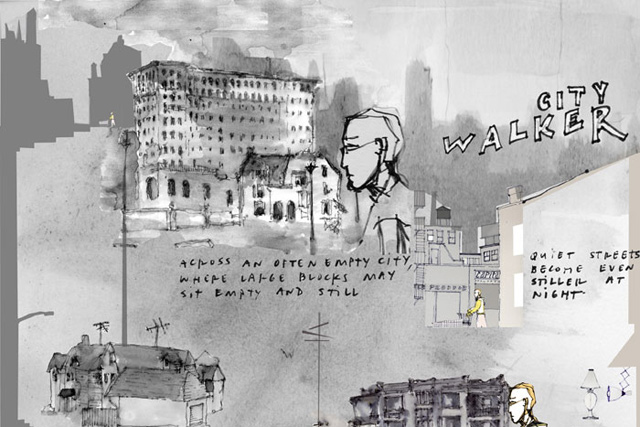
This is part of an ongoing set of one-question emails sent to people we know, or would like to get to know, about things that interest us and inform our collective practice. They’ll be featured on the site weekly, usually on Fridays. These questions are more about unfolding ideas than about the people we’re asking, but we do ask those kinds of questions too.
We’re ecstatic to continue this project with a question for a recent artist-in-residence at Homework: Infrastructures & Collaboration and all-around excellent Detroit neighbour, Nick Tobier.
What does art do for people who experience something that they don’t necessarily read as being art?
An intuitive response to anything, I think, an honest encounter with the world is just about as direct and honest as you can get in having an experience. Wonder, puzzlement, pique, bemusement, delight–I am a big fan of all that swirling around before we pause and recognize what it is or why it is.
Once it is pinpointed and sorted, and understood amidst all of the other things it most closely resembles, the experience may or may not be (art) but it is starting to fade.
Wonder, for instance, that I imagine 14th century pilgrims to Chartres Cathedral saw when they looked up at the stained glass windows. That may be a type of awe-inspiring transcendent encounter with art, where a gut response is flushed with sheer scale and visual information.
Expectations and context affect just about everything, so with the pilgrimage, I suppose you are somewhat primed for something perspective-shifting. And while maybe that’s too grandiose a claim or romantic a vision, I’d stand up and say that the revelatory experiences I aspire to tend to the wonder/bemusement spectrum up there with revelation
The pilgrim takes off purposefully to encounter an inspiring experience. Our contemporary equivalent (perhaps without the religious directive) may know far too much to be enraptured by a visual display. Tell me it is art ahead of time, and my expectations are set to judge. But shift from the cathedral or its near equivalents in cultural significance to a more everyday context–a suburban strip mall, a highway, an intersection, a routine sequence in life. Here is where the struggle to achieve transcendence is most needed today. If even for a split second, we can sidestep the expectations of what the next second is going to look, sound or feel like, the seconds after that will be infinitely possible.
Nick Tobier (that’s me) would say (I do) that he does public construction. Nick studied landscape architecture at Harvard’s Graduate School of Design and subsequently worked as a landscape architect in private practice and with the New York City Department of Parks and Recreation/Bronx Division. Through individual and collective work, Tobier’s interest in the potential of public places has manifested itself in built public projects and actions in San Francisco, Detroit and New York, internationally from Toronto to Tokyo, and performances on the stage and in the streets from Milan to Paramaribo, Suriname and at The Edinburgh, Minneapolis and Philadelphia Fringe Festivals.
In his work and teaching, currently as an Associate Professor in the School of Art & Design at The University of Michigan, Tobier focuses on the integration of art and society, and actively challenges artists to expand their self-definitions and scope. These efforts have included partnerships with artists and farmers; critical and celebratory involvements between artists, art students and broad communities; lectures as performances and vice-versa; and a growing commitment to lasting partnerships working with creative individuals and communities in Detroit.
